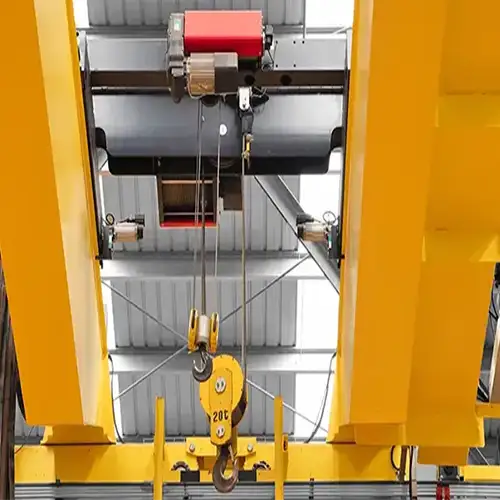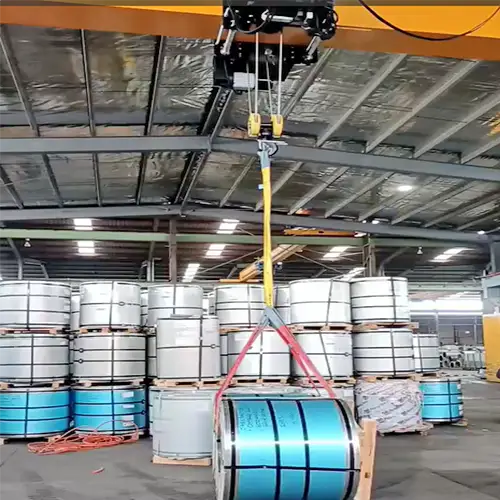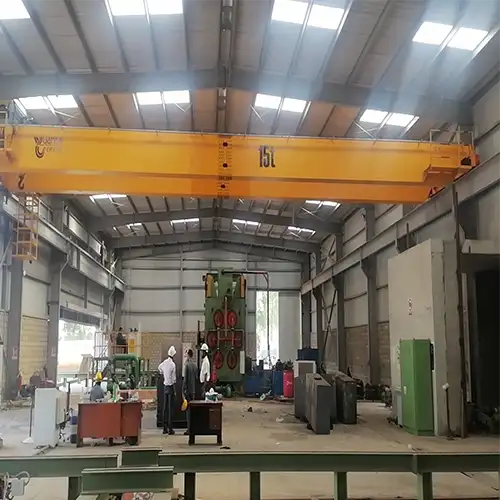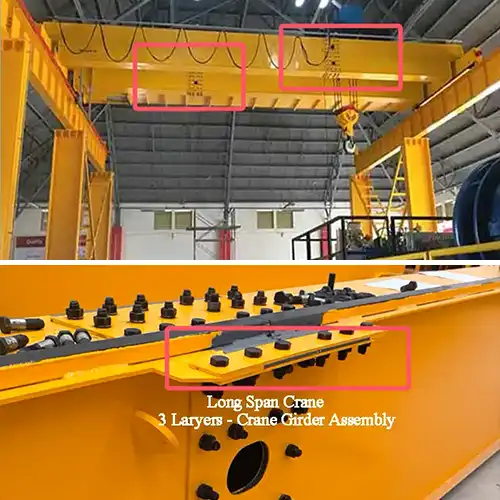Types of Double Girder Overhead Cranes for Sale
Types of double girder overhead crane for sale in China. Hot Sale 3 ton to 320 ton Double Girder Overhead Cranes in China for Different Industrial Sectors
Category: Featured
Your Trusted Overhead Crane Manufacturer & Supplier
Types of Double Girder Overhead Cranes for Sale
Hot Sale 3 ton to 320 ton Double Girder Overhead Cranes in China for Different Industrial Sectors
Introduction
Double girder overhead cranes are a go-to solution when the job calls for serious lifting. They're built to carry heavier loads, run across longer spans, and offer better lifting heights than single girder types. That's why you'll find them in places like steel plants, power stations, mining operations, and heavy equipment factories.
But here's the thing—just choosing a double girder crane isn't enough. What makes these cranes truly adaptable is how they can be tailored in two critical ways: the type of hoisting system they use and the lifting attachment that hangs under the hook. Both elements can make or break your lifting operation, especially when you're dealing with challenging materials or unique production setups.
Why Classification Matters
Double girder cranes aren't "one size fits all." The wrong match can lead to slower workflow, higher maintenance costs, or even safety issues. That's why it helps to understand what types are available and what they're really good for.
Here's how we'll break it down:
- By Hoisting System Whether you're using an electric hoist trolley or an open winch system matters, especially when it comes to how often and how heavy you lift.
- By Industrial Application Some cranes are purpose-built—like those used for hot metal in foundries or explosion-prone zones in chemical plants.
- By Lifting Attachment The device that grips or holds the load—hooks, magnets, grabs, beams—can completely change what a crane is capable of doing.
This guide will help you see the different types of double girder overhead cranes available in the market, and how to select the one that actually works for your material handling job—not just looks good on paper.
General Classification of Top Running Double Girder Overhead Cranes
When buyers start looking at double girder overhead cranes made in China, especially the top running type, one thing becomes clear—there are a lot of options. That's not a bad thing, but it does mean you'll want to know how they're generally classified. Most of these cranes can be grouped by three main aspects: hoisting system, control method, and application area.
A. By Hoisting System
This is one of the most important differences to understand because it directly affects the crane's lifting capacity, duty level, and structure size.
Electric Wire Rope Hoist Trolley (LH, NLH Types)
- These cranes are ideal for medium-duty applications, with lifting capacities generally ranging from 3 to 63 tons (LH) or up to 80 tons (NLH).
- LH uses traditional CD/MD hoists—it's reliable and cost-effective, especially for workshops and machine shops.
- NLH uses European-style hoists, offering lower headroom, smoother travel, and energy-efficient motors.
- Suitable for factories where space is limited, but a strong and stable crane is still required.
Open Winch Trolley (QD, QDX Types)
- Designed for heavy-duty lifting, typically handling loads from 3 tons up to 550 tons.
- QD is the traditional Chinese hook crane with robust structure and long-term durability.
- QDX is the European-style upgrade—compact, quiet, and precise, using inverter control and modular design.
- These are best suited for steel plants, heavy manufacturing, foundries, and industrial applications with high lifting frequency.
By Control Method
How the crane is operated matters for both safety and ease of use. Chinese double girder cranes are commonly available with the following control modes:
Cabin Control
- An operator sits in an enclosed cabin mounted on the crane itself.
- Ideal for heavy-duty and high-risk environments, such as steel mills or casting cranes, where the operator needs a close view of the load.
Remote Control (Wireless Radio Control)
- Allows the operator to stand at a safe distance, walk along with the load, and adjust position flexibly.
- Often used in modern factories and outdoor yards where safety and visibility are important.
Pendant Control (Wired)
- A wired controller hanging from the crane system.
- Cost-effective and simple, used in workshops and facilities with clear, unobstructed operating zones.
By Industrial Application
Double girder overhead cranes are not limited to one industry. In fact, many models are designed with specific sectors in mind, and Chinese manufacturers usually offer crane types tailored to the following:
General Workshops and Manufacturing Plants
- Cranes like LH and NLH are typically used here for moving machine parts, components, and materials along production lines.
Steel Mills and Rolling Plants
- Heavy-duty QD, QDX, QC (magnetic), and QDY (casting) types are common for lifting billets, slabs, coils, and hot ladles.
- Additional features may include heat-resistant parts, electromagnetic lifters, or high-temperature brakes.
Foundries and Metallurgy Plants
- Require insulated cranes like QY or casting cranes like YZ for handling molten metal with specialized ladle hooks or beams.
Power Plants and Waste-to-Energy Plants
- Bulk material handling cranes like QZ with grab buckets are used for feeding boilers or ash removal.
- Often equipped with 24/7 duty systems and precise control for continuous operation.
Chemical and Hazardous Environments
- Explosion-proof cranes such as QB or QBX types are designed with ATEX or EX protection, ensuring safety in volatile environments.
Precast Concrete Yards and Tunnel Projects -
- Tandem-lifting cranes like QE or segment lifters with spreader beams are used for large concrete molds, tunnel lining segments, and long structural parts.
This classification gives a solid overview of what to expect when browsing double girder cranes from Chinese suppliers. It helps you narrow down which crane type suits your needs—whether you're lifting steel coils in a rolling mill or precast panels in a concrete yard. And if you're still unsure, sharing your working conditions and material types with the supplier is always a smart move. They've likely seen your case before.
Your Trusted Overhead Crane Manufacturer & Supplier
Overview of Popular Double Girder Overhead Crane Models in China
If you're sourcing double girder overhead cranes from China, you'll quickly come across a few standard model types—each with its own strengths, limitations, and intended applications. These models form the core offerings of most Chinese crane manufacturers and are usually available with a range of customization options.
Let's break down the most common models used in the market today.
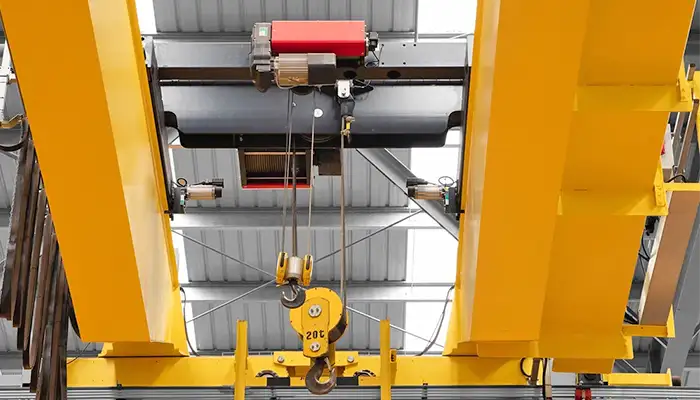
NLH – European-Style Double Girder Crane with Hoist Trolley
The NLH type crane is built to European FEM/DIN standards, offering a lighter, smarter, and more compact design compared to traditional models. It's ideal for medium-duty lifting applications where space and energy efficiency are key.
Typical Application:
- Assembly workshops
- Maintenance shops
- General manufacturing halls
Key Features:
- Lifting capacity: 3 to 80 tons
- Design: Modular and low headroom
- Trolley: Electric wire rope hoist with inverter drive
- Structure: Welded box girder with compact end trucks
Practical Notes:
- Great for replacing older, bulkier cranes where building height is limited
- Offers smoother start/stop and better positioning accuracy
- Slightly higher price than LH, but often lower lifecycle cost
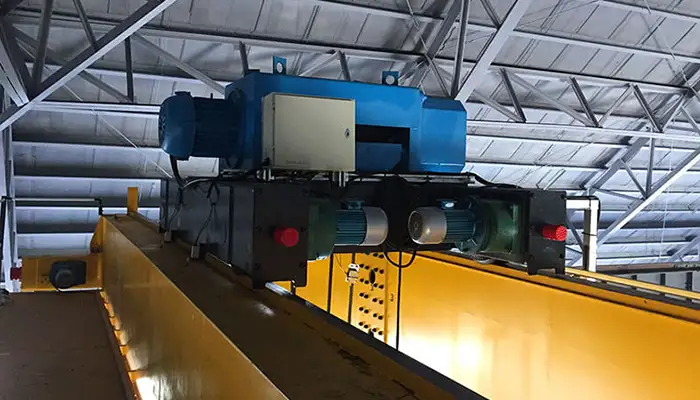
LH – Standard Double Girder Crane with CD/MD Hoist Trolley
The LH model is the most economical option for customers who need a reliable crane for regular operations without complex motion control. It's been widely used in China for decades and is proven in workshops and general fabrication.
Typical Application:
- Machine part handling
- Tooling workshops
- Moderate usage warehouses
Key Features:
- Lifting capacity: 3 to 63 tons
- Hoist system: Traditional CD/MD wire rope hoist
- Structure: Double box girders with simple end carriage design
- Duty class: A3–A5 (light to medium)
Practical Notes:
- If you're on a budget and don't need advanced control features, this is the go-to model
- Maintenance is simple, parts are easy to source
- Not recommended for high-speed or high-precision lifting
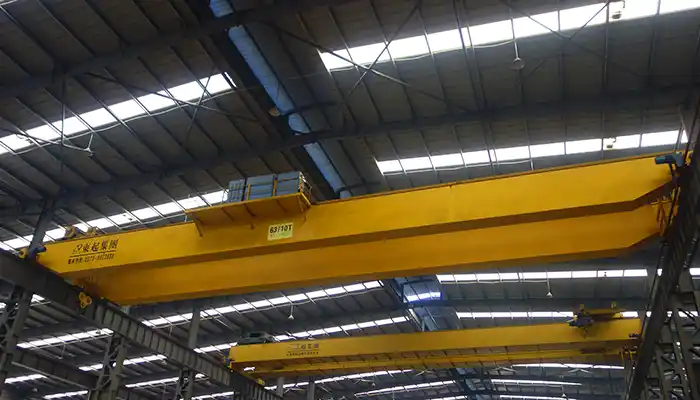
QDX – European-Standard Open Winch Double Girder Crane
QDX is the advanced version of the traditional QD model, designed to meet higher performance demands. It uses a compact open winch trolley instead of a hoist trolley, giving it higher lifting capacity, better precision, and less overall height.
Typical Application:
- Tool & die handling
- Mold factories
- High-precision machinery assembly
Key Features:
- Lifting capacity: 3 to 320 tons
- Control: Full inverter control (hoisting, cross travel, long travel)
- Winch system: Modular open winch trolley
- Structure: Compact box girder and flexible layout
Practical Notes:
- Better suited for customers seeking smoother, more accurate operations
- Energy-efficient motors and reduced noise compared to traditional QD
- Often chosen for exporting to Europe or high-standard international clients
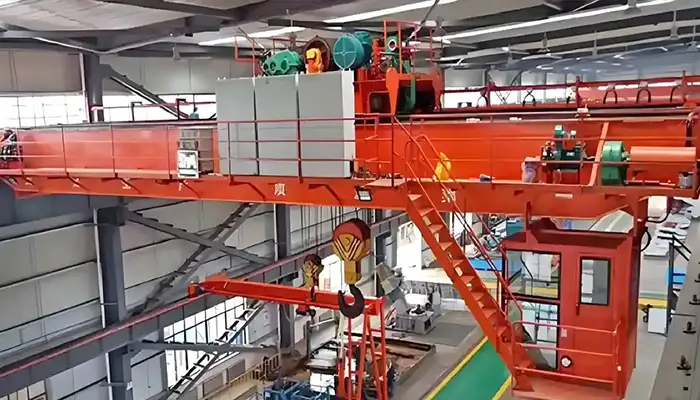
QD – Traditional Double Girder Overhead Hook Crane
QD cranes are known for their rugged, heavy-duty structure and are built for tough industrial environments. While not as compact as the European QDX, the QD type is a workhorse that can be customized up to very high capacities.
Typical Application:
- Steel plants
- Power stations
- Large machinery workshops
Key Features:
- Lifting capacity: 3 to 550 tons
- Trolley: Heavy-duty open winch trolley
- Design standard: GB/T standard (China National Standard)
- Duty class: A5–A7 (medium to heavy duty)
Practical Notes:
- Widely used across Asia and Africa for its durability and affordability
- Suitable for frequent heavy lifting, including multiple shifts
- Requires a bit more installation height than QDX due to its size
These four models represent the core lineup of double girder overhead cranes made in China. While they share the same basic double-girder configuration, the difference lies in their trolley type, motion control, and intended usage. Choosing the right one depends on your load weight, duty cycle, space limitations, and budget.
Quick Comparison – Popular Double Girder Overhead Cranes in China
| Model | Hoisting Type | Capacity | Main Use | Features | Price Level |
|---|---|---|---|---|---|
| NLH | Electric hoist (Euro style) | 3–80 tons | General industry, low headroom workshops | Compact, energy-saving, inverter control | ★★☆☆☆ (Medium) |
| LH | Electric hoist (Standard) | 3–63 tons | Workshops, light fabrication | Simple, cost-effective, easy to maintain | ★☆☆☆☆ (Low) |
| QDX | Open winch (Euro style) | 3–320 tons | Machinery, molds, precise handling | Smooth control, compact, quiet | ★★★★☆ (High) |
| QD | Open winch (Standard) | 3–550 tons | Steel mills, heavy industry | Strong, proven design, heavy lifting | ★★★☆☆ (Medium-High) |
Your Trusted Overhead Crane Manufacturer & Supplier
Industry-Specific Double Girder Overhead Cranes
Not every lifting job is the same—and neither are the cranes. In China, many double girder overhead cranes are specially developed for use in specific industries or demanding environments. Some are built for high heat, some for magnetic loads, others for tandem lifting or manual control where power isn't always available.
| Industry Sector | Crane Models | Main Uses | Capacity Range |
|---|---|---|---|
| Steel Production & Handling | QD, QDX, QC, QL, QG | Lifting coils, plates, billets, long steel products | 5 – 550 tons |
| Metal Casting / Foundry | QDY, YZ, QY | Handling molten metal ladles in high-temp environments | 3 – 320 tons |
| Bulk Material Handling | QZ, QW | Grabbing scrap, ore, coal, garbage, granular materials | 5 – 30 tons |
| Hazardous Environments | QB, QBX | Explosion-proof lifting in gas or chemical plants | 5 – 75 tons |
| Precision Manufacturing | QDX, NLH | Controlled lifting in high-accuracy workshops | 3 – 80 tons |
| Precast Concrete Yards | QE, QPR | Tandem lifting or long segment handling | (10+10) – (200+200) tons |
| Shipbuilding & Assembly | QCS, QE, QED | Lifting ship blocks, molds, oversized structures | 10 – 300 tons |
| Machining & Fabrication | LH, NLH | General-purpose hoist trolley lifting | 3 – 63 tons |
| Recycling & Scrap Yards | QC, QZ, QL | Magnetic or grab-based scrap lifting | 5 – 50 tons |
| Nonferrous Metal Workshops | QY | Insulated cranes for aluminum and magnesium smelting | 1 – 50 tons |
| Off-grid / Manual Operation | SQ | Manual cranes for power-limited or explosion-proof zones | 1 – 10 tons |
Metallurgy & Foundry
When it comes to working around molten metal, you need cranes that can stand up to high temperatures, dust, and intense duty cycles. Chinese crane manufacturers offer several models designed just for this purpose.
QDY – Casting Crane (Light Ladle Use)
- Capacity: 3–74 tons
- Handles molten iron or steel ladles
- Equipped with heat protection, ladle hook, thermal insulation
- Often paired with electromagnetic brakes and dual redundancy systems
YZ – Heavy Ladle Casting Crane
- Capacity: 75–320 tons
- For steel mills with large-volume hot metal handling
- Includes high-temp motor protection and slow-down functions for safety
- Capacity: 1–50 tons
- Used in electrolyzing workshops (aluminum, magnesium)
- Features insulation between hook and trolley to prevent electric shock
2. Steel Handling
Lifting steel coils, billets, plates, or long tubes requires special lifting tools and cranes built for high-load accuracy.
- Used in steel mills and scrapyards
- Equipped with magnetic chuck or magnetic beam
- For fast and safe handling of plates, scraps, and bars
- Designed for lifting long and heavy steel items like pipes, slabs, and steel sheets
- Features suspended magnet beams with multiple lifting points
QG – Hanging Girder Crane
- Uses customized lifting spreaders or beams
- Suitable for long, awkward shapes that are hard to lift with standard hooks
3. Bulk Handling
Some materials—like coal, ore, sand, or waste—can't be lifted with hooks. That's where grab cranes come in.
- Equipped with clamshell or orange peel grab
- Used for loading and unloading bulk cargo or loose scrap
- Ideal for ports, power plants, or material stockyards
QW – Waste Incineration Crane
- Specially designed for 24/7 operation in waste-to-energy plants
- Handles waste feeding, ash removal, and slag
- Designed for corrosive environments and high-duty cycles
4. Explosion-Proof Applications
Hazardous areas need flameproof cranes to prevent accidents. Chinese cranes can be built with full explosion-proof components.
QB – Standard Explosion-Proof Crane
- For oil refineries, chemical plants, paint shops
- Motors, switches, and wiring are explosion-protected
- Rated for zones with flammable gases or dust
QBX – European-Style EX Crane
- Compact and lightweight design with VFD control
- Lower energy consumption and higher lifting precision
- Suitable for clients with higher safety and operational standards
5. Tandem Lifting & Large Item Handling
Large objects like wind turbine components, long molds, or bridge segments need more than one lifting point.
QE – Double Trolley (Tandem Lifting Crane)
- Dual trolleys running on the same bridge
- For synchronized lifting of long and uneven loads
- Perfect for transformer assembly or tank lifting
QED – Four-Point Lifting Crane
- For extremely large structures like tunnel lining segments, bridge decks, or precast blocks
- Custom hoisting synchronization system built-in
6. Precast Concrete & Shipbuilding
Some industries need precise mold handling or lifting of large concrete panels and segments.
QPR – Precast Segment Crane
- Designed for precast yards, metro tunnel segments, and infrastructure projects
- Equipped with custom lifting beams to ensure safe lifting and rotation
QCS – Shipbuilding Mold Crane
- Used in hull assembly workshops
- Handles ship blocks, molds, and large steel plates
- Can be built with tandem trolley control and micro-speed for accurate positioning
7. Manual / Off-Grid Applications
Sometimes, electricity isn't available—or explosion risk is too high for standard electric cranes.
SQ – Manual Double Girder Crane
- For basic material handling where electric power is not allowed
- Suitable for workshops, storage buildings, or emergency backup lifting
- Also useful in hazardous gas zones where ignition sources must be avoided
These specialized cranes are not just modifications—they're built from the ground up for their specific jobs. Whether it's the heat of a foundry, the dust of a bulk yard, or the precision of a precast plant, there's a double girder crane from China made to fit. Just make sure you match the model to your load type, working condition, and required features—and you'll be one step ahead in your project.
Your Trusted Overhead Crane Manufacturer & Supplier
Classification Based on Below-the-Hook Lifting Attachments
A double girder overhead crane is only as versatile as what hangs beneath its hook. While the crane structure and trolley provide the lifting power, it's the below-the-hook devices that determine what kind of materials you can actually move—and how safely and efficiently you can do it.
Chinese manufacturers offer a wide range of lifting attachments, each one suited for specific load types. Choosing the right attachment can drastically improve productivity, reduce damage to materials, and ensure safer operations.
Let's go through the most common lifting attachments used with double girder cranes:
| Lifting Attachment | Main Use / Load Type | Typical Crane Models | Capacity Range |
|---|---|---|---|
| Standard Hook | General lifting: pallets, tools, machines, containers | QD, LH, NLH | 3 – 550 tons |
| C-Hook | Lifting horizontal steel or aluminum coils | QD, QDX | 5 – 50 tons |
| Electromagnet (Circular/Rectangular) | Steel plates, bars, scrap metal | QC, QL | 5 – 75 tons |
| Magnetic Hanging Beam | Long steel products: pipes, billets, rebar | QL | 10 – 100 tons |
| Spreader Beam / Lifting Beam | Long or flexible loads: molds, panels, precast segments | QE, QG, QPR | (10+10) – (200+200) tons |
| Grab (Clamshell / Orange Peel) | Bulk materials: scrap, sand, coal, waste | QZ, QW | 5 – 30 tons |
| Ladle Hook / Ladle Beam | Hot molten metal ladle handling | QDY, YZ | 3 – 320 tons |
| Vacuum Lifter | Fragile, smooth materials: glass, paper, steel plates | NLH, QDX (customized) | 1 – 20 tons |
| Coil Tong / Vertical Grab | Vertical lifting of steel coils | QD, QDX | 5 – 30 tons |
| Slab Tong / Plate Clamp | Horizontal slabs or plate stacks | QD, QDX, QC | 10 – 100 tons |
1. Standard Hook
The most basic and universal lifting tool.
- Found on almost all standard cranes like QD, LH, and NLH
- Works well for general lifting: pallets, machines, containers, parts
- Available in single-hook or double-hook configurations depending on load distribution
- Often paired with slings, chains, or shackles
Best for: General manufacturing, machinery workshops, maintenance bays
2. C-Hook
Designed specifically for coils—especially in steel and aluminum processing plants.
- Fits into the inner bore of horizontal coils to lift without touching the outer surface
- Avoids damaging delicate coil edges and maintains material integrity
- Requires precise balancing and stable control during lifting
Common with: QD or QDX cranes in rolling mills and coil storage areas
Capacity range: Usually 5–50 tons, but can be customized
3. Lifting Magnet (Circular or Rectangular)
Ideal for handling ferrous metal products, especially when speed matters.
- Types: Circular magnets for scrap, rectangular magnets for plates and rebar
- Powered by electricity (often with battery backup in case of power failure)
- Can be electromagnetic or permanent magnet depending on usage and safety needs
- Some magnets include adjustable lifting force or load sensing
Used with: QC, QL cranes in steel mills, warehouses, and scrap yards
Typical use: Steel plates, billets, bundles, scrap metal
4. Spreader Beam / Lifting Beam
Used when the load needs to be supported from multiple points to avoid bending or stress.
- Common for long, flexible, or heavy items like pipes, precast panels, tanks
- Spreader beams can be fixed-length or adjustable
- Often paired with slings or lifting clamps
- Custom-built to match load length and weight distribution
Used in: QG, QE, QPR cranes
Industries: Precast concrete, wind energy, steel structure fabrication
5. Grab Bucket (Orange Peel or Clamshell)
Designed for materials you can't hook—like sand, ore, grain, or garbage.
- Clamshell grab: Two smooth shells for soft bulk like grain, fertilizer, or sand
- Orange peel grab: Multiple "fingers" for handling irregular materials like scrap or garbage
- Can be hydraulic or mechanical, motorized or cable-driven
- Some grabs include auto-locking and dust control features
Used with: QZ, QW cranes in ports, waste plants, power stations
6. Ladle Beam / Ladle Hook
Made for the safest possible lifting of molten metal in foundries and steel plants.
- Includes heat protection, double safety limiters, and emergency brakes
- Designed to support ladles used for carrying liquid steel or iron
- Requires accurate alignment and high safety control, especially in high-heat zones
Used in: QDY, YZ cranes
Duty cycle: High, continuous, and extreme temperature environments
7. Electromagnetic Hanging Beam
A specialized attachment combining magnet power with beam stability.
- Designed for lifting long steel items (pipes, bars, plates) evenly
- Features multiple magnets placed along a beam to spread the load
- Ensures the load doesn't sag or rotate during lifting
- Can be operated from the cabin or remotely, often with variable control
Used with: QL cranes in large-scale steel yards
Bonus: Some beams can adjust magnet spacing to handle different material lengths
8. Vacuum Lifters (Optional Custom)
Used when you need a gentle, mark-free grip on smooth, flat materials.
- Ideal for lifting glass panels, paper rolls, stainless steel sheets, and other sensitive loads
- Uses suction cups with a controlled vacuum system
- Often includes tilt and rotation features for placing materials precisely
- Requires clean and smooth surfaces to create a proper seal
Common in: Glass factories, paper mills, clean production areas
Available as: Fixed or mobile attachments, often integrated with safety sensors
Final Note:
Choosing the right lifting attachment is just as important as choosing the crane itself. If you're lifting coils, scrap, molten steel, long beams, or bulk waste, a standard hook won't cut it—and using the wrong tool can risk damage, injury, or costly downtime.
Always confirm:
- Load type and shape
- Weight distribution
- Temperature or environmental risks
- Speed and frequency of lifting
If you're unsure, just ask your crane supplier—they can usually recommend the right lifting attachment based on a simple drawing or sample specs.
How to Choose the Right Double Girder Crane & Lifting Device
Selecting the right double girder overhead crane is not just about lifting capacity or crane size. It's about making sure the crane—and the lifting device underneath—suits your specific working environment, load type, and operational needs. Making the right choice from the start can save time, avoid safety risks, and reduce maintenance issues later on.
Here are the most important factors you should define before making a final selection or requesting a detailed quotation:
| What to Think About | What You Need to Know | Why It Matters |
|---|---|---|
| Type and Shape of Load | Are you lifting coils, plates, scrap, or something else? | Different loads need different lifting tools. |
| Weight of Load | How heavy is the load? What's the heaviest you'll lift? | Make sure the crane can handle your heaviest loads safely. |
| How Often You Lift | How many hours a day and how many lifts per hour? | Helps decide how strong and durable the crane needs to be. |
| Work Environment | Is there heat, dust, explosion risk, or chemicals nearby? | Affects the materials and safety features the crane needs. |
| Space and Height | How wide is the space? How high do you need to lift? | The crane has to fit and reach the right places. |
| Speed Control | Do you need simple speed or precise control? | Controls affect safety and how smoothly loads move. |
This way, you can quickly understand what's important before buying a crane!
1. Load Type & Shape
Start by identifying what you plan to lift. The physical form of the load determines what type of lifting attachment you'll need and how the crane should be configured.
- Coils require a C-hook or coil tong for safe lifting without damaging the outer edge.
- Steel plates, billets, or bars are best handled with lifting magnets or magnetic beams.
- Loose materials like sand, coal, or scrap need grab buckets—either clamshell or orange peel.
- Molten metal ladles demand ladle hooks or ladle beams with high-temperature protection.
- Long, flexible loads such as precast panels, pipes, or beams benefit from spreader beams with multiple lifting points.
- Fragile or smooth items like glass or paper rolls may require vacuum lifters to avoid surface damage.
It's useful to send photos or drawings of the loads you handle when requesting a solution.
2. Weight Range
You'll need to know both the typical and maximum weights of your loads.
- Always choose a crane rated at least 10–20% higher than the heaviest load you plan to lift.
- Consider whether the load will be lifted as a single unit or in bundled form.
- Avoid oversizing unnecessarily, as this can increase the crane's cost and energy use.
If your load weights vary widely, a dual-speed or variable-speed hoisting system can help maintain control during both light and heavy lifts.
3. Lifting Frequency & Working Hours
Your crane's operating schedule directly affects what duty class or working grade it should have.
- Light duty (A3) is for occasional use, such as light maintenance or storage areas.
- Medium duty (A4–A5) suits factories and general workshops with regular lifting.
- Heavy duty (A6–A8) is required for steel plants, casting shops, and production lines with continuous lifting.
Always choose a duty class that matches your daily workload. Underspecifying this can lead to early wear or system failures.
4. Heat, Dust, Explosion Risk, or Corrosion
Environmental conditions can have a big impact on crane design and material selection.
- High temperatures above 60°C require cranes with thermal insulation and heat-resistant components.
- Dusty conditions or granular exposure call for sealed control cabinets and dust protection.
- Explosion-prone areas need explosion-proof cranes with certified motors, brakes, and wiring.
- Chemical or waste treatment environments may require anti-corrosion coatings or stainless components.
Be sure to inform your supplier about nearby furnaces, gas zones, or outdoor exposure so they can make the right material and protection choices.
5. Crane Span & Hook Travel
Crane size must match your workshop or yard dimensions to avoid costly modifications during installation.
- Crane span is the distance between runway rails—measure this accurately and account for any deviation.
- Lifting height (hook travel) refers to the distance from the ground to the highest hook position. Consider clearance under your loads as well.
- If space near walls or columns is tight, ask about low-headroom trolleys or short-end approach designs.
If you're replacing an existing crane or using an old runway beam, it helps to provide drawings or layout measurements early on.
6. Required Speed Control
Crane movement speed affects both productivity and safety, especially in high-precision or repetitive operations.
- Single-speed systems are cost-effective for simple, occasional use.
- Dual-speed systems allow better load control and are useful when handling both light and heavy materials.
- Inverter control (VFD) enables stepless speed variation, giving operators full control over positioning and reducing load swing.
- Tandem lifting systems require synchronized VFD control, especially when using two trolleys or two cranes lifting the same load.
When loads are long, heavy, or fragile, inverter-controlled speed makes operation smoother and more stable.
Final Advice for Buyers
Before choosing a crane, make sure you have a clear list of your working conditions and load characteristics. This will help your supplier offer a tailored solution that's safer, more efficient, and better suited to your operation.
Here's a quick checklist to prepare before contacting your crane supplier:
- What type of load will be lifted (shape, size, and material)?
- What is the maximum weight to be handled?
- What is the crane span and required lifting height?
- How many hours per day will the crane operate?
- Are there any environmental conditions like heat, dust, or explosive gas?
- What kind of control method do you prefer—cab, remote, or pendant?
Once you've got this information, choosing the right double girder overhead crane—and the right lifting attachment—becomes a much easier task.
Conclusion
No two lifting jobs are exactly alike—and that's especially true when it comes to double girder overhead cranes. Whether you're working in a steel plant, foundry, bulk handling terminal, precast yard, or a hazard-prone chemical workshop, the demands of your site require more than just a standard crane.
Choosing the right double girder crane model, along with the correct below-the-hook lifting attachment, ensures that your operations stay safe, efficient, and cost-effective over the long term. A well-matched system not only improves material flow and handling time but also extends equipment lifespan and reduces operator fatigue.
Here's what we offer to help you make the right decision:
- Tailored crane design based on your load type, site layout, and duty cycle
- Modular hoisting systems ranging from compact hoist trolleys to heavy-duty open winches
- Custom lifting attachments including C-hooks, magnetic beams, ladle spreaders, grabs, and more
- Technical guidance from experienced engineers who understand industrial lifting challenges
- Compliance with international standards (FEM, ISO, GB/T, CE) for global buyers
If you're planning a new installation, upgrading existing equipment, or sourcing for a specific application, we're here to help. Just send us a brief description of your working conditions—load type, crane span, lifting height, and environmental factors—and we'll provide a free design recommendation along with a competitive quotation.
Let us help you build a lifting solution that works—not just for now, but for years to come.
Related Products
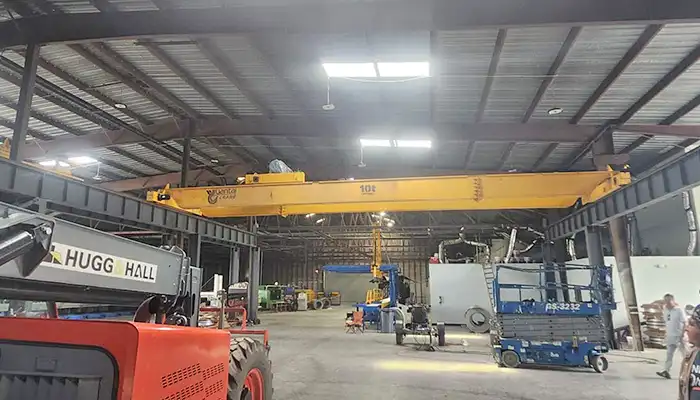
Affordable 10 ton double girder overhead crane with CD/MD hoist trolley, built for U.S. standards, ideal for construction and industrial lifting
Free consultation to Confirm Parameters & Specifications and Get
Latest Crane Price & Crane Rate.
- Types of overhead cranes : _______?
- Optional: Overhead travelling crane, goliath gantry crane,Slewing jib crane, Single girder or double girder crane,small portable crane or kbk crane, etc.
- Capacity of overhead crane: _______?
- Optional: 0.25ton, 0.5 ton, 1 ton, 2 ton, 3ton, 5 ton, 10 ton,15ton, 20ton, 25 ton, 30ton,35ton, up to 550ton, etc.
- Crane span & lifting height : _______?
- Crane travelling length : _____?
- Control of overhead crane:_______?
- Optional: pendant/ remote/cabin control
- Voltage supply of overhead crane:_____?
- Eg,: 380V50/60HZ,3Phase or others,etc.
- Application/usage of crane:_______?
- Eg,: Steel mill, ,injection mold, cement,stone, concrete,granite, general manufacturing, etc.
Just leave a message via the contact form and our hoist and crane engineer will contact you with in 24working hours.
Get In Touch
